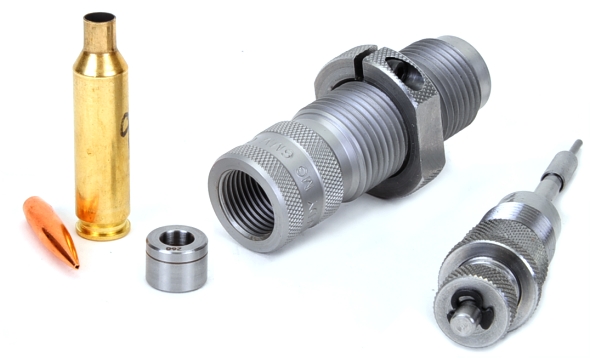
The hold ups on accuracy testing of the 6mm Creedmoor and Ruger American Rifle Predator were three fold: awaiting for the arrival of a 0.268″ neck bushing for the Hornady Match die set, taking the time to make an overall length gauge modified case for the 6mm Creedmoor and a willingness on my part to clear a path through the snow field that once was our test range. Clear the range? Sit in warm office? Clear the range? Sit in warm office. Of course, clear range… although that truth was surely not held as self evident.
*There are a couple of loose ends I’d like to tie up…
The neck through hole in the unbushed Hornady Match sizer die measured 0.278″ with a pin gauge, so the die without bushing has no influence when sizing a fired case, even though this is a full length sizer die. Running a fired case through the die with a 0.268″ bushing in place sized its neck to 0.269″, with an inside diameter of 0.240″. When seating a 115 Berger bullet that measured 0.2425″, the case neck outside diameter expanded to 0.271″… and a tick, a very small tick.

Making a modified case from a case fired in a specific rifle produces very accurate overall length results, but only for that rifle and only if handloading and using a neck rather than full length sizer. For anything else, any unfired brass as a starting point would do as well. An H drill and 5/16″-36 tap seems to produce the cleanest threads in cartridge brass.
| Bullets Left to Right | Type | Nominal Weight |
Measured Length “ |
Potential Maximum COL” |
Handload Assembled COL” |
| Berger VLD Target | HP | 115 | 1.352 | 2.892 | 2.750 |
| Hornady ELD | Poly Tip | 108 | 1.225 | 2.800 | 2.700 |
| Berger VLD Hunting | HP | 105 | 1.220 | 2.860 | 2.720 |
| Speer | BTSP | 100 | 1.045 | 2.701 | 2.600 |
| Hornady V-Max | Poly Tip | 65 | 0.840 | 2.635 | 2.440 |
| Sierra BlitzKing | Poly Tip | 55 | 0.748 | NA | 2.425 |
| NA = Bullet could be seated out until it was out of the case. | |||||
Neither throating or magazine length, 2.846″, limited the COL of assembled cartridges. Overall length was established as one caliber of bullet shank contact inside the case neck. I do not subscribe to “Part the bullet on the leade” theories for several reasons. In the olden days when rifles were chambered on lathes with leather drive belt and imprecise reamers, chamber throats could be quite oversize. If machines didn’t leave throats egg shaped and oversize, people pushing massive amounts of ammo through hot barrels could erode them until bullets had a direction choice when set free from the cartridge case.
To avoid relying on throat size as a factor in guidance, precision shooters pushed the bullet as far forward as possible so that the bullet’s ogive was sitting on the transition from groove to leade for the best support. For anyone without precision shooting skills and/or rifle built on pet competitive shooting theories of the day, this is a waste of time and, in most case, not even possible. Today’s heavily monitored and controlled precision machined and hammer forged chambers have a 6mm spec throat diameter of 0.2435″ and a groove diameter of 0.2430″.
I get a kick out of reading gun boards where someone says, “I’m trying to control bullet jump to rifling….” as though the bullet is a salmon leaping its way upstream. There is no jump and the bullet is going nowhere other than straight down the barrel after the bullet violently collides with rifling under high pressure. On the other front, barrel steel is so much better, so eroded throats of consequence are pretty much a thing of the past for 99% of the rifle in use. For the one percent that puts 7,000 – 10,000 rounds through a barrel, they tend to change barrels or at least set them back when accuracy falls off.
 |
Warning: Bullet selections are specific, and loads are not valid with substitutions of different bullets of the same weight. Variations in bullet material and length will alter net case capacity, pressure and velocity results. Primer selection is specific and primer types are not interchangeable. These data represents maximum loads in our firearms and test equipment and may easily be excessive in other applications. All loads should be reduced by 3%, and developed following safe handloading practices as represented in established reloading manuals produced by component manufacturers. Presentation of these loads does not constitute a solicitation for their use, nor a recommendation.
|
||||||||||||||||||||||||||||||||||||||||||||||||||||||||||||||||||||||||||||||||||||||||||
|
|||||||||||||||||||||||||||||||||||||||||||||||||||||||||||||||||||||||||||||||||||||||||||
All of the handloads in Part 2 are valid from a velocity and pressure standpoint, however, the list was trimmed down to the best performing in terms of accuracy and velocity. The Ruger American Rifle Predator was, as they always are, an extremely accurate firearm. The 6mm Creedmoor is a nice variation on the Creedmoor theme, giving the hunter a different range of bullet weights for varmint to deer hunting applications. The tighter than typical 6mm twist rate proved stabilizing with heavy, long bullets, but not the least bit disruptive with lighter weight bullets in the 6mm range.
If the 6mm Creedmoor and essential cartridge? I do not shoot competitively and I live in the land of trees growing ten feet apart, but with proper bullets and loads it could still be quite the effective Maine deer rifle. I think the real star here is the Ruger American Rifle Predator and it is available in numerous accuracy delivering cartridges: 204 Ruger, 223 Rem, 22-250 Rem, 243 Win, 6mm Creedmoor, 6.5 Creedmoor, 308 Win

Email Notification